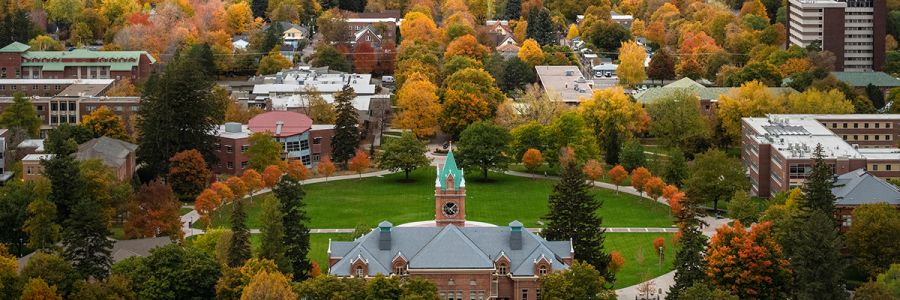Possibilities Unlimited: A Decade of Modernization, Growth and Expansion
During the 1960s, UM Foundation donors fueled state-of-the art research and helped to transform the University into a global hub of innovation and leadership.
May 13, 2025
This story is part of “75 Years of Impact,” a celebration marking the University of Montana Foundation’s 75th anniversary. Throughout the year the Foundation will share stories illustrating the profound impact of donors’ philanthropy at the University of Montana across the decades. To learn more visit SupportUM.org/UMF-75.
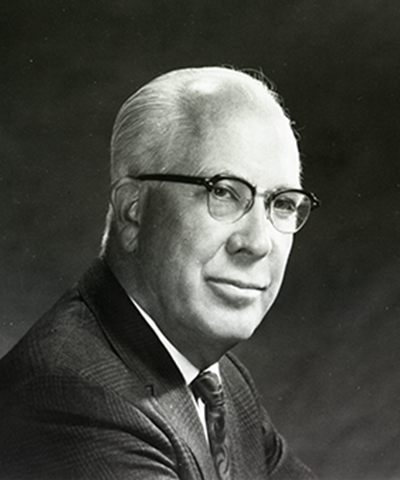
“Possibilities unlimited.”
That’s how D. Gordon Rognlien described the burgeoning impact of philanthropy at the University of Montana while addressing students at a leadership conference at Flathead Lake Lodge in May 1960.
One of the nine original founders of the UM Foundation at its incorporation on Nov. 18, 1950, Rognlien had witnessed firsthand the rapid evolution of the University’s giving community. By fall 1960, he’d be elected Chair of the Foundation’s Board of Trustees — and his optimism about the University’s potential for transformational growth quickly proved correct.
During the 1960s, donor support gained momentum, and the Foundation helped modernize infrastructure, fuel research and elevate UM to a position of national and global leadership in education and innovation.
Advancing Cutting-Edge Research
At a September 1960 Foundation Board meeting, UM President Henry K. Newburn outlined two immediate goals for the University: expand research capacity and raise the school’s academic profile on a global stage.
The University’s vision resonated with donors, launching a decade of support for student scholarships, faculty resources and advanced technologies.
One early milestone came with the donor-funded purchase of high-resolution photomicrographic equipment, allowing researchers to capture images of organisms invisible to the naked eye, including viruses and microscopic life in remote mountain lakes and streams. The investment strengthened UM’s standing in environmental and biological sciences and opened doors for impactful student and faculty discoveries.
But perhaps the most important leap forward came a few years later, when donors rallied to support the addition of a truly state-of-the-art machine: UM’s first computer.
Leading UM into the Computer Age
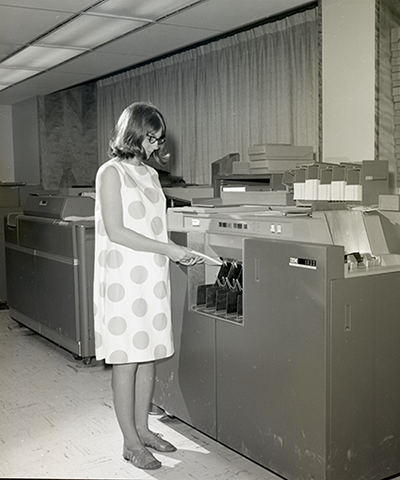
As the educational and scientific needs of society evolved in the early ’60s, University and Foundation leaders considered computer technology an essential investment in UM’s future.
“The high-speed computer is a key tool in the latter half of this century ... particularly in the fields of education and research,” said Jack Corette, chair of the Foundation’s computer fundraising initiative, launched in 1962.
Corette said every department on campus would benefit from the purchase of a computer and, within two years, donors contributed the necessary funds. UM’s first computer center opened in the basement of what is now the Dennis and Gretchen Eck Liberal Arts Building in early 1964.
The new machine was available for any student or faculty member to aid in their research, data management or problem solving. The center also featured a mathematics lab, reference library, seminar room and staff offices. The mathematics department launched programming courses, including night classes for community leaders interested in using the computer.
A Montana Kaimin article from the time described the new eight-component IBM Processing System as: “a core storage unit, a card reproducer, card sorter, data processor and two machines that type cards.” The computer could also play tic-tac-toe and address “about 100 envelopes in five minutes.”
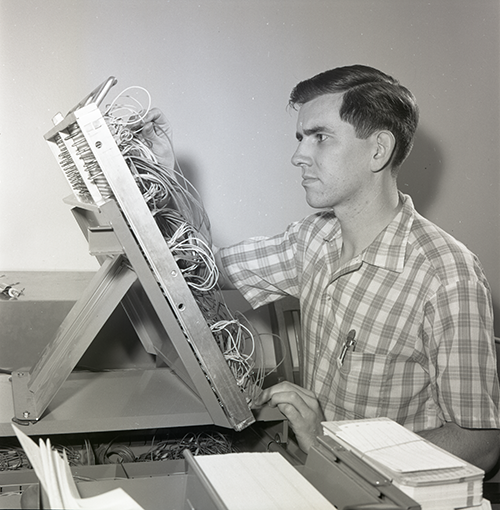
Donor support of UM's technological infrastructure not only helped the University keep pace with national trends but also laid the preliminary groundwork for the cutting-edge fields explored on campus today.
In 2025, areas of significant advancement include the emerging study of data science, cybersecurity and artificial intelligence, as UM’s many supporters continue to make good on the University’s promise to keep students at the forefront of technology and exploration.
Inspiring World-Renowned Leadership
Aug. 24, 1967, was a star-studded night in Washington, D.C., as nearly 1,000 political and cultural luminaries gathered at the Sheraton Park Hotel to honor Senate Majority Leader Mike Mansfield.
The Washington Post called the jovial, bipartisan evening a “rare and special tribute” to a man who had spent 25 years representing Montana in Congress and had become one of the most influential figures in American politics. The event — which was co-sponsored by the UM Foundation — drew cabinet members, ambassadors, military leaders, journalists and dignitaries, including Secretary of State Dean Rusk and Sen. Robert F. Kennedy.
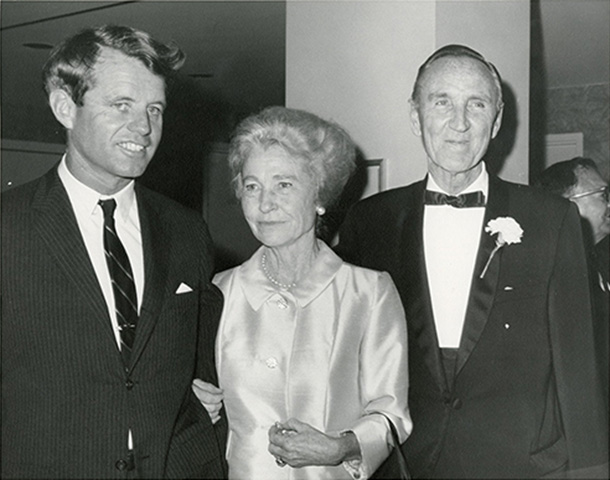
Yet the evening was more than just a celebration of Mansfield’s life in politics. It was also the launch of the Mansfield Endowment of the University of Montana Foundation, a private philanthropic effort to create an international lecture series at UM.
Led by a prestigious founding committee — including Vice President Hubert Humphrey, First Lady of the United States Lady Bird Johnson, former First Lady of the United States Jackie Kennedy, UM President Robert Pantzer and former Montana Governor Tim Babcock — the Mansfield Endowment galvanized interest and support across the political spectrum.
Jackie and Robert F. Kennedy presented a $10,000 gift in the name of late President John F. Kennedy. President Lyndon B. Johnson sent his personal endorsement, writing, “I know of no more appropriate tribute to a great American. I wish the Foundation and its supporters every success in their noble endeavor.”
Mansfield, known as a humble, down-to-earth statesman, told the crowd he credited his wife Maureen as his “wise counselor and steadfast” partner.
“Without her, I would not be in the United States Congress,” he said.
Thanks to that visionary support and contributions to the Foundation, the Maureen and Mike Mansfield Lecture Series has become a cornerstone of excellence at UM.
Over the decades, the series has attracted leading experts in political science, international relations, the humanities and more, becoming one of the University's best-known public features. The groundbreaking lectures continue to draw crowds in Missoula and resonate across the globe.
Recent Mansfield lecturers include Pulitzer Prize-winning bestselling author Doris Kearns Goodwin and former Secretary of State Condoleezza Rice, while earlier distinguished speakers included economist Milton Friedman and historian Barbara Tuchman, as well as New York Governor, future Vice President of the United States Nelson A. Rockefeller, and former President Jimmy Carter.
Through private and public support, the legacy of the Mansfields lives on at UM. In 1983 the Maureen and Mike Mansfield Center was founded at the University by an Act of Congress and donors continue to support its efforts to foster globally minded leaders of integrity and distinguish the University as an international hub of leadership and dialogue.
Annual Giving Takes Root
Rognlien’s remarks to students came just a month after the launch of UM’s first large-scale annual giving initiative — a major step toward cultivating consistent support. This drive aimed to meet the rising demands of a growing student body and ensure flexible funding for the University’s most immediate needs.
Driven by an energetic, student-led letter-writing campaign, the effort quickly gained traction. By Jan. 1, 1961, UM administrators reported more than 1,200 donors had contributed over $13,000 to the UM Foundation — equivalent to more than $140,000 today.
“Vital work in education and research cannot be undertaken unless there is financial help from former students and friends of UM,” said Pantzer.
Funds raised supported student aid, library acquisitions, research, athletics, the Law School Development Fund, the President’s Fund and more.
Since the founding of the UM Foundation, the annual support and engagement of the UM community — alumni, friends, organizations and parents — have strengthened the University and helped to propel its advancements and its accessibility for students.
Today, the Foundation’s annual giving program continues to play a pivotal role in carrying on a powerful tradition: donors stepping up each year to uplift the University’s evolving mission through continual support of crucial needs and priorities across campus.
Setting Course for the Future
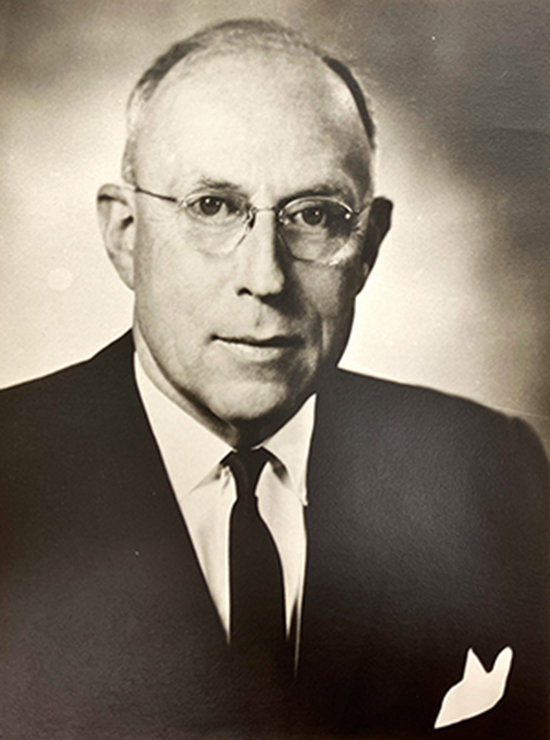
During the fall of 1967, the Foundation hired Oakley Coffee — another original Trustee — as its first full-time Director. At the close of the 1960s, what had begun as a modest, volunteer-led movement in 1950 had transformed into a professional force capable of serving thousands of donors who prioritized higher education and research in Montana.
By 1969, the UM Foundation managed nearly $4 million in total assets, with an endowment portfolio exceeding more than $1 million. More than financial success, these figures reflected the strength of public-private collaboration and donor belief in the University’s mission.
Through this support, the Foundation laid out a plan for growth that continues to this day. Indeed, through the unity and vision of the University’s many donors, the possibilities had become — and remain — unlimited.
To learn more about the Foundation’s 75th anniversary and read feature stories spanning the decades, please visit SupportUM.org/UMF-75.
The information on this website was compiled from a variety of sources, including records held by the UM Foundation and the Maureen and Mike Mansfield Library Archives and Special Collections. The UM Foundation has made its best efforts to provide an accurate representation of events, people, entities, names, activities and data. However, the information presented should not be considered a definitive historical record.
